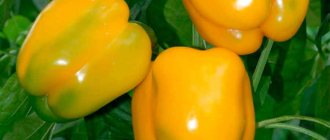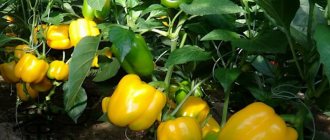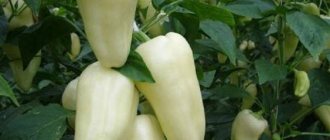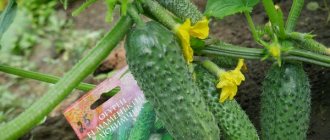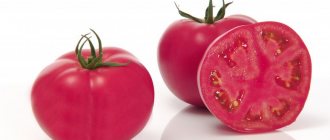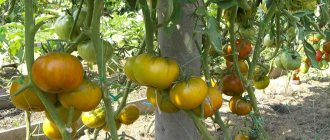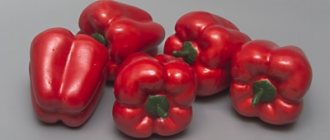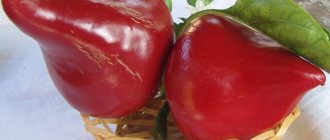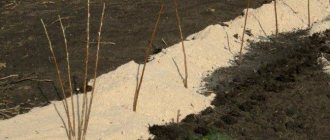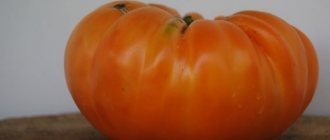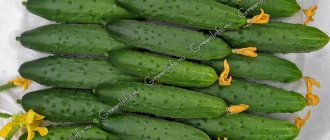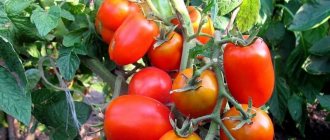| Ripening period: | late-ripening |
| Fruit shape: | bell |
| Taste qualities: | medium-hot |
| Color: | red |
| Productivity: | 1.5-2.0 kg per bush |
In Russia, a huge number of pepper varieties are grown, which are divided into sweet and hot. But you can find varieties with an average level of sweetness and spiciness. In addition to the unique taste, the Bell pepper has an exotic fruit shape, which increases interest in the variety. In this case, the bushes can be grown in closed or open ground, depending on the planting region.
What type of pepper is this?
The Bell pepper variety differs from others in the interesting shape of its fruit, which resembles flower buds. This species is becoming increasingly popular in Russia, becoming an exotic decoration for garden plots.
Characteristics and description of the variety
Bellflower is a late-ripening variety.
This is a rather tall, up to 2 m tall, spreading plant, the leaves and stem of which are slightly covered with fluff. The fruits have an original shape: similar to a bell flower. At first they are dark green, a little later orange, and when fully ripe they become bright red.
From one Bluebell bush you can harvest about 2 kg of harvest. This variety of pepper can be grown in open ground, in a greenhouse or in a pot.
Distinctive features
The difference between this variety and others lies not only in the interesting appearance of its fruits, but also in its unusual taste combination. The part of the fruit near the tail is bitter, reminiscent of hot pepper, and below, where the fruit looks like a flower, its walls thicken and become sweet and sour in taste.
Fruit characteristics, yield
The fruits of this pepper are smooth and shiny. Their weight depends on growing conditions and reaches 70-90 g. The walls are fleshy, about 4 mm thick. Number of cameras - 2-3. Productivity is relatively high. The fruits reach maturity 130-140 days after planting the seeds. From 1 m² you can harvest 5 kg of fruit.
Characteristics and description of the variety
Bell - a variety of hot pepper, the region of admission for cultivation is the entire territory of the Russian Federation. This pepper can be planted in private plots on open beds and under film shelters. Variety Bell is late-ripening (95 days from planting to technical ripeness).
The description of Bell pepper is as follows:
- bush of medium size, semi-spreading;
- the leaf is also medium in size, slightly wrinkled, colored light green and green;
- the pepper is drooping and has a prism-shaped shape;
- the skin is smooth, highly glossy;
- unripe fruits are greenish-white, fully ripe peppers are red;
- the thickness of their walls is 2-4 mm;
- seed chambers in each pepper - 2-3 pcs.;
- taste – spicy or semi-sharp.
The productivity of the Bell pepper variety is high - 4.0-5.5 kg per m2 of beds covered with film. The average weight of one pepper is from 70 to 90 g.
Characteristics of the variety:
- early ripeness;
- average height;
- demanding cultivation and care;
- original shape of the fruit;
- long fruiting (until autumn frosts);
- good yield.
Small fruits of the Bell pepper variety are eaten fresh, added to dishes to give them a pleasant spicy taste, preserved whole and in combination with other vegetables, pickled, and dried. The transportability of this hot pepper is excellent; it can be transported over long distances without problems, as well as stored in suitable conditions - in a dark, cool place.
Preparation for cultivation
Preparing for growing the Bell variety is no different from other types of pepper. It is not fresh seeds that germinate better, but those that were collected 5 years ago. They begin to sow seedlings in February, checking the lunar calendar.
They start by soaking the seeds in Epin or Fitosporin. Sometimes they are pre-treated with a manganese solution. Then the seeds are wrapped in a wet cloth and plastic wrap and left in a warm place until the sprouts hatch.
The soil for planting is preheated to 20 °C.
Agrotechnics of cultivation
Since the variety is new to the market, seeds can only be purchased from proven reliable places, as there is a high probability of substitution.
Sowing seeds
In order to have time to get the pepper harvest before the cold snap, bell pepper seeds are prepared for sowing in mid-February:
- Disinfect in a weak solution of potassium permarganate for 20 minutes.
- Wash in water.
- Soak for 5-6 hours in growth stimulants or solutions of microelements.
- The treated seeds are wrapped in a damp cloth, placed in a bag or jar with a loose lid, which is placed in a warm (25 degrees) place. Since the germination process lasts several days, it is necessary to periodically add water, but in no case do not overwater the seeds, but only slightly moisturize the fabric.
Land for seedlings can be purchased at the store or prepared in the usual way - by mixing garden soil with compost and ash. The mixture should be light but nutritious. To disinfect, it can be treated with a solution of potassium permarganate or another preparation.
Summer residents plant Bell pepper not in dozens, but in several pieces, so the soil for seedlings is placed in planting pots and moistened. Large containers for growing peppers are not needed, since the root system of peppers is poorly developed.
Sowing begins when the seeds have hatched - one at a time into a container. The seeds are covered with soil (1 cm), covered with film or paper and left to germinate in a warm (25-26 degrees) place.
Growing seedlings
Bell pepper does not tolerate picking, so it is better to sow the seeds immediately in separate cups. Nutrient soil with sand and peat is added to the seedling containers, watered with “Fitosporin” and the sprouted seeds are carefully laid out. Sprinkle 1.5-2 cm of soil on top, cover with a lid, and leave in a warm place. When sprouts appear, the trays are moved to a well-lit windowsill.
Attention! Protect seedlings from drafts, otherwise the plants may die.
Planting pepper
You can plant peppers in open ground when the threat of frost has passed and the ground has warmed up well. By that time, up to 12 leaves will appear on the seedling. The growing place should be well lit and sheltered from the wind. It is best if legumes, cabbage or cucumbers grew there the previous year.
Seedlings should be replanted in the evening or in cloudy weather. Bushes are planted at a distance of at least 45-50 cm from each other.
You need to add a handful of ash to the planting holes, and after planting, pour in a solution of manganese. The ground around the bushes can be mulched to protect it from weeds and drying out.
If the weather worsens, the plantings can be covered with film.
Further care
Subsequent care for Bell peppers is almost no different from other varieties. Here are some features:
- in bushes it is necessary to pinch the side shoots growing below the first ovary;
- water moderately and only with warm water so as not to stress the plants;
- Fertilize the Bluebell 3 times per season - 2 weeks after planting, add mullein diluted with water 1:10, during the flowering period, water it with a solution of wood ash, after 3 weeks add minerals (potassium, phosphorus and calcium);
- before flowering it is recommended to carry out treatment against pests;
- a month before harvesting, pinch all the shoots to allow the pepper to ripen;
- You can also harvest it green; such fruits are sweeter. The pungency appears in them as the color changes to red. This happens literally in a week.
Important! The variety is perennial; over time, the plant trunk becomes rough and covered with bark. As the temperature drops, the leaves fall off. For the winter, the pepper needs to be transplanted into a tub and moved to a warm room. With the arrival of spring, buds will appear on the Bluebell again.
Pepper growing technology
Growing peppers in your own garden is easy. It is enough to follow the cultivation technology, and then the harvest will delight you with abundance.
- Preparing seedlings. First of all, it is worth planting the seedlings. Planting work should begin in February. To begin with, you should prepare containers, fill them with soil, and sow seeds. The container must be placed in a room with a temperature of no more than 24 degrees.
- Thinning. As soon as the shoots appear, it is necessary to pick. Plants must be carefully removed from the pot and planted in separate containers.
- Hardening. If the weather is warm outside, you can take the seedlings out into the fresh air.
- Lighting. In winter, pepper is undemanding to lighting. However, there is no need to darken cultures. In the summer, you need to make sure that bright light reaches the plants.
- Watering. It is necessary to water the seedlings moderately and in a timely manner. For irrigation you need to use warm water. In summer, the amount of watering should be increased.
- Topping. As soon as flowering begins, pinching is required.
Features of growing the variety and possible difficulties
Those wishing to grow Bell peppers may encounter some difficulties. The main one is that the seeds are rarely found on sale; it is better to look for them from gardeners who have already grown this variety.
Bushes can reach a height of 2 m, so the beds need to be equipped with supports so that stems that are not too strong can rest on them.
If you are planning a perennial crop, then you need to plant the seedlings in tubs with holes in the bottom. This will allow you to take the plants outside in the warm season, and with the first frost, take them into the warmth.
The variety is suitable for year-round fruiting if grown in a greenhouse.
Planting peppers in the garden
After the seedlings have 3 leaves, you can plant the plants in the garden bed. According to calendar dates, the period falls in May. At this time, the temperature should be at least 13 degrees.
You may be interested in: Favorable days for planting pepper for seedlings in 2021: terms and rules for sowing at home Favorable days for picking pepper in 2021 according to the lunar calendar Favorable days for sowing sweet and bitter pepper for seedlings in 2021
Planting must be done carefully. The roots of the plant are very sensitive and should never be damaged. Landing is best done in the evening.
The choice of site should be approached responsibly. It should be sunny and windless. You need to pour ash into the garden bed and pour in a solution of potassium permanganate. Then you should make a hole and plant the plants. Mulch the soil and water it. The row spacing should be at least 40 cm.
Typical diseases and pests
The most common diseases affecting Bell pepper:
- Gray rot covers the leaves with gray spots. In advanced cases, the plant dies. In the initial stages of the infection, it is necessary to cut off the infected branches, and if the disease has spread to the entire bush, it is necessary to treat it with the Gamair fungicide (add 10 tablets per 10 liters of water).
- Anthracosis covers the plant with brown spots and leads to death. A 1% solution of Bordeaux mixture can help in the fight against this disease. Prevention is done by regular loosening of the soil.
- Blackleg is a disease caused by a fungus that causes the stem to turn black. Fitosporin-M is used for treatment.
How to get rid of black leg of seedlings
The most common pest of Bell pepper is the aphid. If the plant is affected by this insect, immediately prepare the following solution:
- Brew 10 g of ground pepper and 200 g of tobacco with boiling water and pour into a 10-liter bucket of water;
- rub some laundry soap there;
- spray the bush and the soil around with the resulting solution.
If the pepper is attacked by the Colorado potato beetle, celandine will help. Beans planted nearby repel these insects.
An infusion of several bulbs and heads of garlic, kept for a week in a bucket of water, is effective against spider mites. The resulting liquid is sprayed onto the pepper bushes.
Bell pepper: cultivation and care
Growing Bell pepper has a number of features. The main one is that seed material is rare in specialized departments and has a high cost. The best option is to purchase from gardeners who have already grown the variety.
Shrubs grow quite large, so they require appropriately sized growing containers. In the spring, they take it outside, and when it gets colder, they take it home.
Bellflower belongs to the late-ripening varieties, however, it is able to bear fruit before the first frost in the fall. For the fastest ripening of fruits, the plant is brought indoors or 1-1.5 months before frost, the buds are removed and the shoots are shortened.
Photo of Bell pepper on a bush
Bell pepper feels great in greenhouse conditions, where it can bear fruit all year round. When growing in open ground, proper selection of a place for constant growth is important.
Peppers are grown using seedlings.
Planting Bell Pepper
Since the variety is a late ripening variety, seeds are planted for seedlings quite early. So, in the northern regions - at the end of February. The best seeds of hot pepper Bell for seedlings - at the age of 3 to 5 years. Experienced vegetable growers do not recommend fresh, just harvested seed.
Photo of the bell pepper variety
A special feature of the Bluebell is that it can be planted immediately in separate pots. Does not like picking or pinching roots. This should be taken into account when germinating seeds.
The prepared seeds are placed in a container 3 cm deep into the soil. Cover with glass or film (you can use food film). Place it immediately in a well-lit place. After the first shoots appear, the cover from above is removed.
Lighting
The bluebell loves well-lit places. If there is a lack of light, it cannot form fully. Therefore, this fact is taken into account when planting in a permanent place of growth, choosing well-lit areas. Also, there should be no plants nearby that block the pepper from light. Already when growing Bellflower seedlings, the location of future plants relative to the light source is changed daily, turning it at an angle of 90 degrees.
The plant definitely needs support, as it reaches 2 meters in height.
Watering
Pepper is responsive to watering. It requires a moderate amount of water for growth and development. Water at room temperature. After watering, to avoid stagnation of moisture in the soil, the soil is loosened.
Planting bell pepper seedlings in open ground
Seedlings are transplanted when a constant temperature is established at a level of 12 to 14 degrees. In this case, the seedlings should have formed several full-fledged leaves. Before planting, one or two weeks before planting, hardening must be carried out.
Read also: How to dilute Kalanchoe for a child’s nose
When planting, maintain a distance of 40-50 cm between the bushes.
The variety loves nutritious, loose, light soil. For seeds for seedlings, the ideal option is a mixture of humus and sand in a 1:1 ratio. The same mixture is added when transplanting to a permanent place of growth.
Bell peppers are grown in 1-3 main stems. When the plant is at the peak of flowering, the formed side shoots below the initial ovary are carefully pinched. A month and a half before the first frost, all flowers are removed and shoots are shortened. This helps the peppers ripen faster.
Fertilizer and feeding of the Bell variety
Fertilizers are applied 3 times per season. The first time - 14 days after planting. Fertilize with diluted mullein. For the flowering period, wood ash is used. The last feeding for the season - after 15-20 days - with mineral feeding with potassium, phosphorus and calcium.
Hot pepper Bell, reviews of which are presented below, is not yet well known and widespread in Russia. Those who have already grown these peppers are happy with the results.
Advantages and disadvantages of the variety
The advantages of this spicy pepper variety are as follows:
- perennial;
- can be grown in soil and in pots;
- high yield;
- can be eaten raw and after heat treatment;
- contains B vitamins, vitamin C and serotonin - the hormone of joy.
The disadvantage is the long period of fruit ripening - about 5 months.
Attention! Fresh bell pepper fruits are recommended to be consumed with caution by people who have problems with the gastrointestinal tract.
Grooming activities
Caring for the crop is not difficult. However, some features should be known in advance.
- Loosening the soil. Plants require loose soil. The procedure should be carried out carefully, without damaging the root system.
- Feeding. For normal development, plants need elements such as potassium and calcium. This is especially true during the period of active growth and flowering.
Note. For the winter, the crop can be replanted in a pot and grown at home.
Reviews
We bring to your attention several reviews from summer residents about this variety.
Evelina, Krasnodar: “The taste is undoubtedly interesting, but I didn’t notice any strong spiciness. The flesh is rather sweet-spicy. All the heat is in the seeds. But the kitchen was pleasantly enlivened when the fruits were ripe.”
Sviridova V., Tula: “On the Internet I came across a description and photo of this variety. I started looking for seeds in stores and couldn’t find them. I had to order from the online store. Of the 15 seeds, 12 sprouted, so I distributed them to friends myself. Pepper bushes are beautiful both during the flowering period and when the fruits are set. Pepper is good fresh or pickled.”
The benefits of Bell pepper and its use in cooking
Red Bell pepper has a spicy taste. It contains a lot of useful substances that have a beneficial effect on the body. Thus, ripe peppers contain a large amount of B vitamins, which promotes the production of the “joy” hormone - serotonin, which is responsible for a good mood.
In addition, it has the following beneficial properties:
- strengthens the functioning of the heart and blood vessels;
relieves the body of cholesterol;
strengthens the body's protective properties;
has a calming effect on the central nervous system;
excellent vision prevention;
- has a cosmetic effect in the form of strengthening nails and hair follicles of the skin.
These are the main beneficial properties of Bell pepper.
Due to its unusual taste, it is widely used in cooking. It is consumed fresh, as part of light salads or simply sliced. Well suited for preparing winter snacks, pastas, sauces.
All of the above advantages are an excellent reason to think about growing the Bell variety.
Reviews about Bell pepper
Lyudmila, Moscow region, 60 years old: “I decided to grow Bell pepper, the characteristics of which immediately interested me. I wanted to try something new and original. Grown in a greenhouse. Everything is fine: we harvested the amount indicated in the description - about 2 kg per bush. The fruits are delicious, eaten fresh.”
Ivan, Vladimir, 56 years old: “At first glance I liked the Bell pepper, the description of which can be summed up in one word - exotic. Starting from the unusual shape and ending with the taste, everything is unusual, although it resembles something between varieties of hot peppers and bell peppers. Grown in an open area. No problem. Excellent harvest."
Pepper Bell: photos, reviews
Valery, Izhevsk, 44 years old: “I saw Bell pepper on the website, reviews of which were not so numerous, read the description and decided to grow it. It was difficult to get it, I had to order it online. Everything worked out without much effort, unlike purchasing seeds, it’s really difficult to find them.”
Video about Bell pepper
The culture is widespread, grown in open ground, greenhouses, greenhouses, and at home.
Bell pepper occupies an intermediate position between the Bulgarian and bitter varieties.
According to the botanical description of the variety, it is a perennial plant bearing spicy, sweet fruits with noticeable sourness. The pungency is slight and manifests itself in the biological stage of ripeness.
